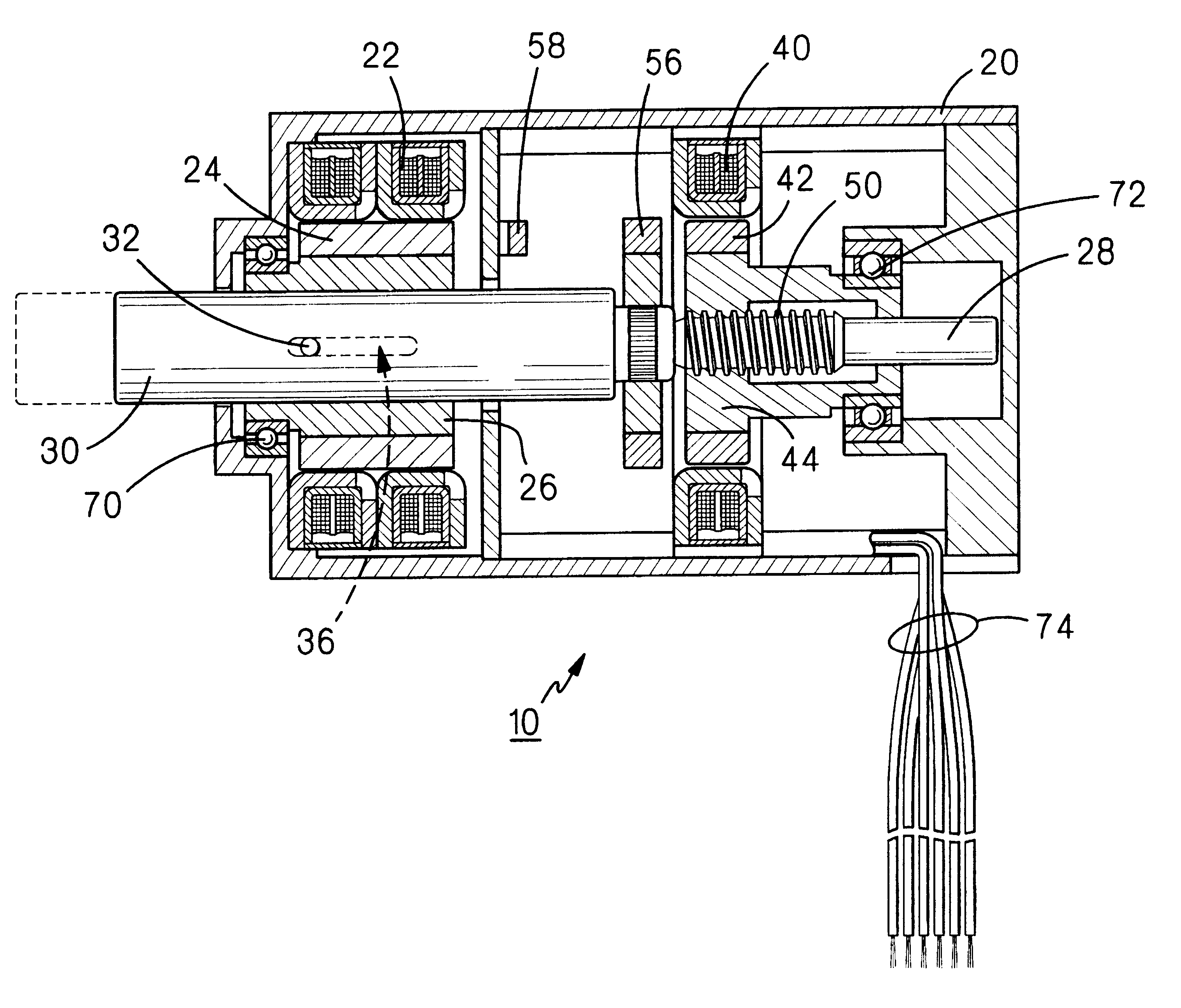Linear/rotary electromagnetic device
a technology of electromagnetic devices and rotating shafts, applied in the direction of dynamo-electric converter control, multiple dynamo-motor starters, applications, etc., can solve the problems of heavy, complicated, and difficult conventional motor arrangements to achieve such motion, and achieve substantial disadvantages for robotic applications
- Summary
- Abstract
- Description
- Claims
- Application Information
AI Technical Summary
Benefits of technology
Problems solved by technology
Method used
Image
Examples
first embodiment
FIG. 1 illustrates a linear / rotary electric motor, constructed according to the present invention, the motor being generally indicated by the reference numeral 10. Motor 10 includes a housing 20 having an annular stator structure 22 fixedly mounted therein in magnetic interacting relationship with an annular permanent magnet 24 fixedly mounted on an annular bushing 26, the latter two elements comprising a motor rotor. A shaft 28 extends coaxially through housing 20 and includes a cylindrical portion 30 extending coaxially through bushing 26. Shaft 28 is secured against rotation relative to bushing 26 by means of a pin 32 extending through and fixedly attached to the bushing and extending through cylindrical portion 30. To permit axial movement of shaft 28 relative to bushing 26, pin 32 extends through an axially extending slot 36 defined through bushing 26.
Housing 20 also includes fixedly mounted therein a second annular stator 40 magnetically interacting with an annular permanent m...
second embodiment
FIG. 2 illustrates a linear / rotary electric motor constructed according to the present invention, the motor being generally indicated by the reference numeral 80. Motor 80 includes a housing 90 having an annular stator structure 92 fixedly mounted therein in magnetic interacting relationship with an annular permanent magnet 94 fixedly mounted on an annular, internally threaded bushing 96, the latter two elements comprising a motor rotor.
Housing 90 also includes fixedly mounted therein a second annular stator 100 magnetically interacting with an annular permanent magnet 102 fixedly mounted on an annular bushing 104, the second stator and the permanent magnet comprising an electromagnetic brake. A shaft 98 extends coaxially through housing 90 and includes a cylindrical portion 110 extending coaxially through bushing 104. Shaft 98 is secured against rotation relative to bushing 104 by means of a pin 116 extending through the bushing and through and fixedly attached to cylindrical porti...
third embodiment
FIG. 3 illustrates a linear / rotary electric motor, constructed according to the present invention, the motor being generally indicated by the reference numeral 20'. Since motor 20' is a variation of motor 20 (FIG. 1), the common elements thereof are given primed reference numerals and reference should be made to FIG. 1 for a description of the elements and the operation thereof to the extent not described with reference to FIG. 3.
The differences between motor 20 and motor 20' is that, in the latter, permanent magnet 56 (FIG. 1) has been eliminated and Hall cell 58 is triggered when approached by permanent magnet 24' of rotor 24' / 26'. Also, motor 20' includes a return spring 150 disposed between bushing 26' and bearing 70' to return shaft 28' to its home position. Return spring 150 may not be required if motor 20' is operating in a vertical position.
PUM
 Login to View More
Login to View More Abstract
Description
Claims
Application Information
 Login to View More
Login to View More - R&D
- Intellectual Property
- Life Sciences
- Materials
- Tech Scout
- Unparalleled Data Quality
- Higher Quality Content
- 60% Fewer Hallucinations
Browse by: Latest US Patents, China's latest patents, Technical Efficacy Thesaurus, Application Domain, Technology Topic, Popular Technical Reports.
© 2025 PatSnap. All rights reserved.Legal|Privacy policy|Modern Slavery Act Transparency Statement|Sitemap|About US| Contact US: help@patsnap.com



